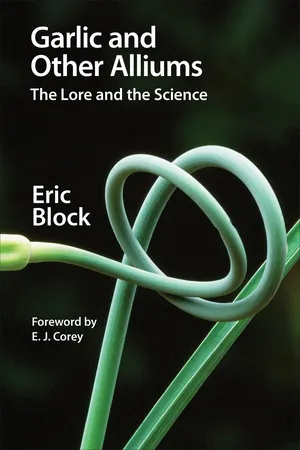1.2.1 The Naming of Alliums
The genus Allium includes some of the most ancient cultivated crops, including A. sativum (garlic), A. cepa (onion), A. schoenoprasum (chives), A. ampeloprasum (great-headed or elephant garlic), A. tuberosum (Chinese or garlic chives), A. fistulosum (Japanese bunching onion) and A. chinense (rakkyo; when listing members of the genus, Allium is abbreviated as “A.”). These seven food crops can be easily distinguished by appearance. Two other edible, strong-smelling Allium species, A. tricoccum (ramp) and A. ursinum (bear’s garlic or ramson; the latter name is derived from “rank,” referring to its smell and taste) grow wild in North America and Europe, respectively, while a third, A. victorialis (caucas or “gyoja ninniku”), is widely consumed in Northern Japan. The shallot, A. ascalonicum, is a variety of the common onion and not a separate species; the separate Latin name is unjustified. The leek, A. porrum, and kurrat, A. kurrat, are cultigens (cultivated plants lacking wild counterparts) of A. ampeloprasum and are therefore members of the same species. A. porrum is the European cultivated leek. A. kurrat, the Middle-Eastern cultivated leek (kurrat, Arabic for leek), is grown for its leaves as a minor crop in the Delta region of Egypt and may be the leek mentioned in the Bible (Musselman, 2002). The scallion, green onion, spring onion and salad onion are simply different forms of A. cepa. Within each of the above species there may be many cultivars (human-selected horticultural varieties of domesticated crops) and subgroups with different characteristics. For example, garlic includes five distinct subgroups: Sativum, Ophioscorodon, Longicuspis, Subtropical and Pekinense. The Sativum group, originally from the Mediterranean region, was adapted by growers worldwide and constitutes the most common form of garlic.
“Sativum” in the botanical name for garlic means cultivated, consistent with the fact that wild “A. sativum” is unknown. The ancient name of garlic from Egyptian papyruses is khidjana. Garlic is called skórodon in ancient Greek, shûm in Hebrew, ajo in Spanish, ail in French, aglio in Italian, Knoblauch in German and suan in Chinese. The fact that the Chinese word for garlic, suan, is written as a single character is offered as evidence of the antiquity of the word, and hence of the ancient use of garlic in China (Kiple, 2000). Garlic was popular enough with the ancient Greeks that a section of the market in Athens was known simply as ta skoroda, “the garlic” (Davidson, 1999). “Garlic” itself is derived from “garleac” or “gar leek,” “gar” meaning “spear” because of the spear-headed cloves (McLean, 1980) and “leac” an Anglo-Saxon root meaning plant or herb (Davies, 1992).
The English “leek” and German Lauch are derived from “leac.” Leeks were so popular with the Anglo-Saxons that their word for a kitchen garden was “leek-garth” (“leac-tun”). The Greek word for leek, prason, is the basis for ampeloprasum (“ampelo”=vine), the Allium that grows in vineyards. The Latin word for leek, porrum, is the origin of its French name, poireau. “Onion” comes from the Middle English “unyun,” which in turn comes from the French oignon. The French name was ultimately derived from the Latin unio, meaning one or unity, because an onion grows as a single bulb, in contrast to the multi-cloved garlic. In Latin, onion was called cepa or caepa, hence the botanical name, and the names cebolla, cebola and cipollo, in Spanish, Portuguese and Italian, respectively.
1.2.2 Allium Botany
The botany and horticulture of alliums have been extensively studied and are the subject of many excellent books (see Bibliography). Allium species growing in particular countries or geographic areas are to be found in flora of those areas, e.g., the Flora of North America (2002), and Wild Flowers of the United States (Rickett, 1973), which respectively identify 96 and 79 different native species. Notable among those who specifically researched the botany of the genus Allium was the eminent nineteenth century botanist Eduard Regel (1815-1892; Figure 1.1; Anonymous, 1892). Scientific Director and then Director General of the Imperial Botanical Garden in St. Petersburg, Russia, Regel was instrumental in getting botanists attached to the Russian expeditions in Central and Eastern Asia. Regel introduced scores of plants to the Garden from Central Asia, described them and distributed them liberally to botanic gardens and nurseries outside Russia. A prolific author, he was a founder of both the Russian and Swiss Horticultural Societies and the journal Gartenflora. He had a particular fascination with the genus Allium and wrote about them in two monographs (Regel, 1875, 1887), which feature more than 250 species, including a large number not previously described, the fruits of the explorations in Asia. More than 60 of the Allium species he helped to identify bear his name in the full name of the plant, e.g., A. giganteum Regel and A. rosenbachianum Regel.
Figure 1.1 Eduard Regel (1815–1892). (Photo provided courtesy of Botanical Garden of the Komarov Institute of the Russian Academy of Sciences, St. Petersburg, Russia).
While the origin of Allium species remains speculative, evidence suggests that garlic and onion were first domesticated in the central Asian mountainous regions of Tajikstan, Turkmenia, Uzbekistan, and northern Iran, Afghanistan and Pakistan (Brewster, 2008), and most likely brought to the Middle East by Marco Polo and other Silk Road/spice route travelers. Recent research pinpoints the northwestern side of the Tien Shan Mountains (e.g., Kyrgyzstan, Kazakhstan) as the most likely center of origin of garlic (Etoh, 2002). Extensive efforts have been made in conjunction with the European Union’s 2000–2004 Garlic and Health Project to collect specimens from the region of central Asia shown in Figure 1.2 (Kik, 2004).
Figure 1.2 Collection of garlic accessions in Central Asia in 2000 and 2001 under the E.U. Garlic and Health project. Red and blue dots indicate garlic accessions collected from market places and natural vegetations, respectively. (Reproduced with permission from: http://www.plant.wageningen-ur.nl/projects/garlicandhealth/Results.htm).
A. ampeloprasum (known to the Romans as Ulpicum: Sturtevant, 1888; Mezzabotta, 2000) is thought to be the ancestor species of leek and kurrat. There is considerable interest in the wild relatives of garlic for plant breeding and future genetic manipulation. It has been suggested that A. longicuspis, genetically identical to A. sativum, might have been cultivated by semi-nomadic hunter-gatherers more than 10 000 years ago and transported along trading routes between China and the Mediterranean. From the Mediterranean region garlic was brought to sub-Saharan Africa and the Americas by explorers and colonists. It is also thought that garlic was introduced to China by traders from Central Asia, and into Japan from Korea, where it was very popular (Etoh, 2002). DNA analysis indicates that neither A. longicuspis nor A. tuncelianum are ancestor species of garlic, as suggested earlier. Therefore the true ancestor species of garlic still remains unknown (Ipek, 2008).
The current taxonomic classification of alliums is:
Class | Monocotyledons |
Superorder | Liliiflorae |
Order | Asparagales |
Family | Alliaceae |
Tribe | Alliae |
Genus | Allium |
In the older literature Alliaceae were included in both the Lilliaceae and the Amaryllidaceae, but they are now regarded as a separate family. Within the genus Allium there are as many as 750 species, making it the largest genus of petaloid monocotyledons, excluding orchids. The taxonomy of alliums is complicated, with a proliferation of synonyms at least equal in number to the number of known species. Since important characters are generally lost in herbarium specimens, study of the living material is essential (Gregory, 1998). Extensive collections of living Allium species may be found at Kew Gardens (UK; 250 species; http://www.kew.org/; Mathews, 1996) and at the New York Botanical Gardens (65 species; http://www.nybg.org/). Cryopreservation appears to be a viable method for archiving small samples of living tissue from Allium species (Volk, 2004, 2009).
Botanists describe alliums as “low growing perennials in which the rhizomes, roots, … and bulbs can be important storage organs. The leaves [tubular in onions, flat in garlic] arise from the underground stem and often have long sheathing bases, which can give the appearance of a stem, as typified by leeks … No leaves occur on the flower stalk (the ‘scape’) except the single spathe that encloses the young inflorescence” (umbel; Brewster, 2008). The bulbs, which often clump, consist of the swollen base of the stem and several fleshy leaves or scales held together by a disk or hardened stem tissue called a basal plate.
There are two main sub-species of garlic, namely hardneck (stiffneck) and softneck (Volk, 2004). Hardneck garlic (Allium sativum ssp. ophioscorodon), also called ophio or top-set garlic, produces scapes or flower stalks and prefers northerly climates with cold winters. When sliced through the bulb midsection, the hardneck type typically reveals a single circle of 6 to 11 cloves around a central woody stalk. Before flowering, the scape (“top set”) curls upward as it grows, looping the loop with 1 to 3 coils, like pig’s tails (Figure 1.3), before straightening and then grows little seed-like bulbils. Garlic scapes are generally pinched off while still looped, three weeks before the bulbs are ready to be harvested, enhancing bulb growth (the scapes are “delicious raw or cooked,” according to one cookbook). Failure to remove the scapes can reduce the yield of the bulbs by as much as 33% (Stern, 2009). Softneck garlic (Allium sativum ssp. sativum), when sliced through the bulb midsection, reveals up to 24 cloves per bulb (but sometimes much less) in several layers aroun...


